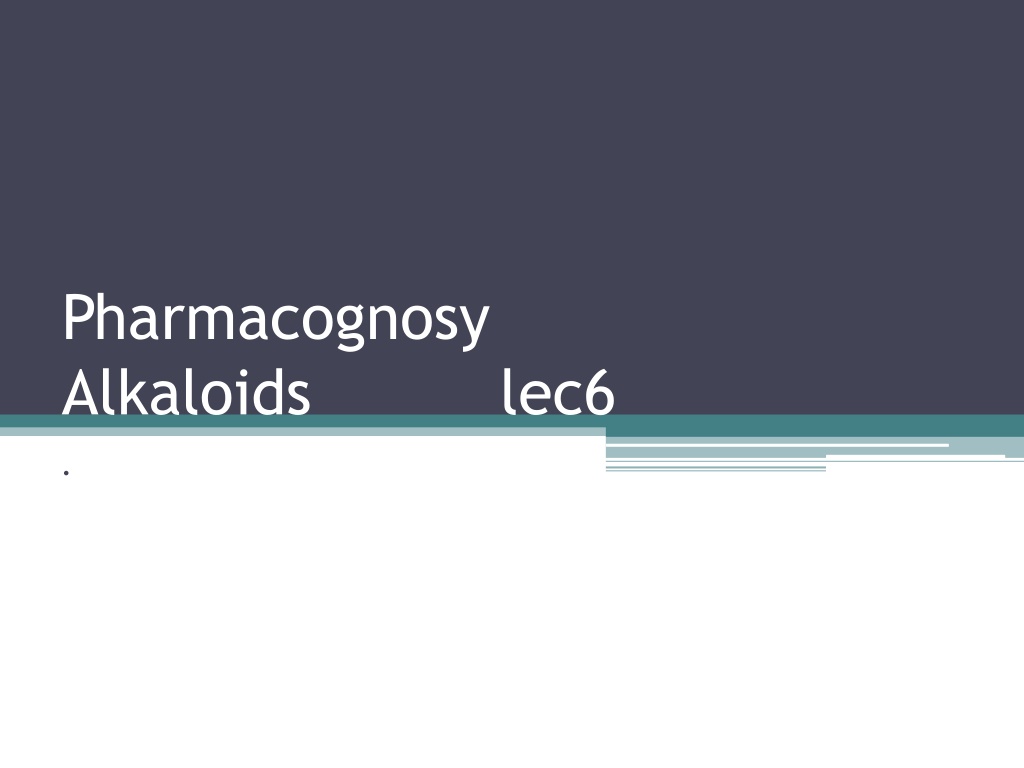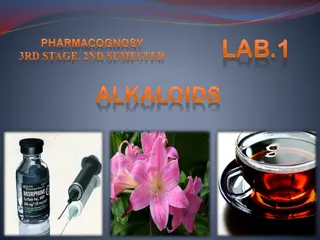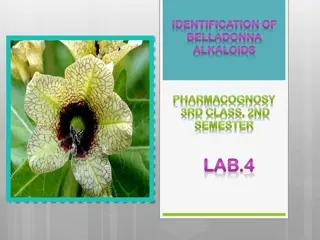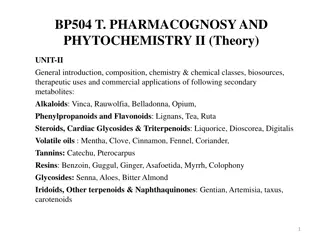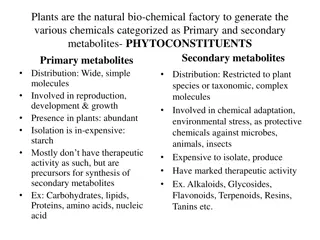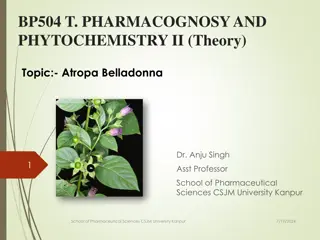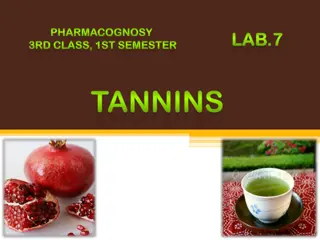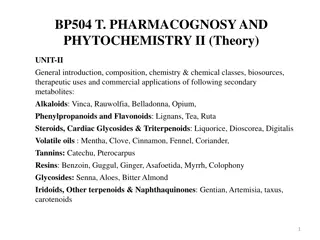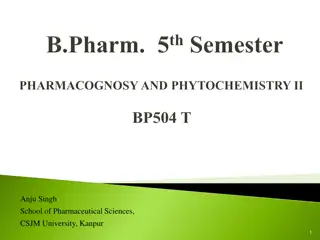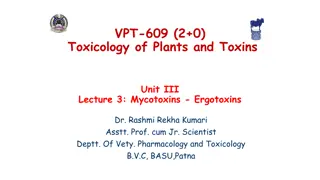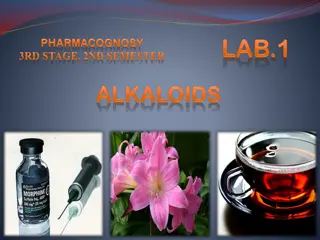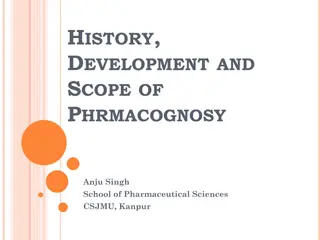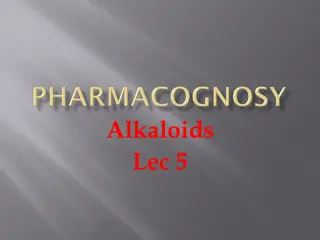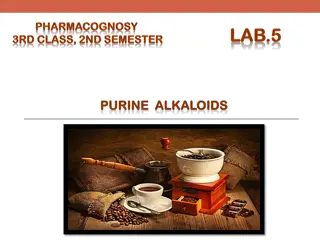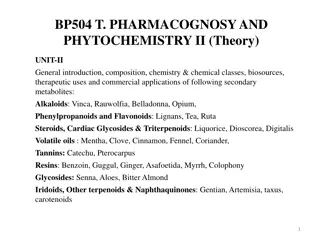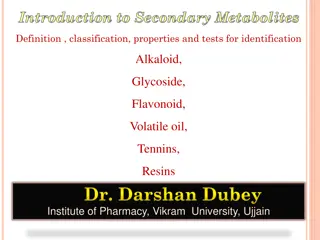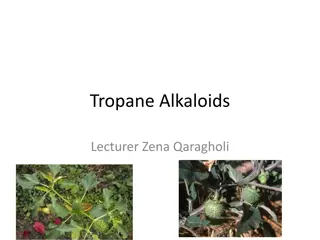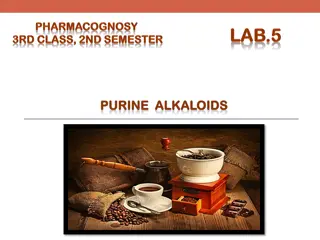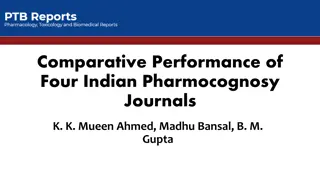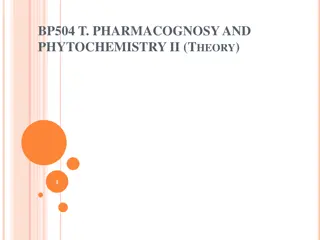Overview of Alkaloids in Pharmacognosy
Alkaloids are a diverse group of compounds containing nitrogen that are derived from amino acids like phenylalanine or tyrosine. Protoalkaloids, such as ephedrine, are derived from common amino acids and do not contain a heterocyclic ring. Ephedrine, obtained from Ephedra sinica, has CNS stimulatory and bronchodilatory properties. Colchicine, derived from Colchicum species, is used in treating gout but is highly cytotoxic. Mescaline, found in cactus peyote, is a hallucinogenic compound. The sale of herbal preparations containing ephedrine-like compounds should be avoided due to safety concerns.
Download Presentation

Please find below an Image/Link to download the presentation.
The content on the website is provided AS IS for your information and personal use only. It may not be sold, licensed, or shared on other websites without obtaining consent from the author. Download presentation by click this link. If you encounter any issues during the download, it is possible that the publisher has removed the file from their server.
E N D
Presentation Transcript
Pharmacognosy Alkaloids lec6 .
Protoalkaloids (biological amine) Alkaloids do not contain a heterocyclic ring. The nitrogen at the side chain. They are derived from the common amino acids, phenylalanine or tyrosine. Some of the alkaloids in this category whose biosynthesis has been studied using labeled precursor include mescaline, ephedrine, cathinone and colchicin.
Ephedrine Ephedrine is derived from Ephedra sinica, Gnetaceae. Ephedrine possess CNS stimulatory, vasoconstrictor and bronchodialatory properities. Ephedrine has two stereogenic (chiral) centres and therefor has four possible isomer. Ephedrine used for sever asthma while pseudoephedrine is used in cough preparation for it s bronchodilatory properties.
Ephedrine Ephedrine_structure Ephedrine Pseudoephedrine (isomer) less stimulant in effect Ephedra sinica, Note - the nitrogen is in the side chain, not the heterocyclic ring! Ma Huang
Herbal Ephedra has recently gained notoriety as herbal ecstasy due to the high similarity in structure of ephedrine and ecstasy, these herbal preparations are dangerous and should therefore be avoided. This is why the sale of pseudoephedrine may be banned....ephedrine is already tightly controlled
colchicine An alkaloid obtained from various species of Colchicum Fam. Liliaceae. Colchicin has one amido nitrogen atom. The compound lacks pronounced basicity and does not form a well-defined series of salts as do other alkaloids. Nevertheless, it is precipitated by many alkaloid reagents and is conventionally considered an alkaloid. Colchicine used in the treatment of gout, it is highly cytotoxic and antimitotic.
Mescaline Mescaline is the biologically active natural product present in cactus peyote which is responsible for it s hallucinogenic properity. Ingestion of pure mescaline fails to give the same response as consumption of peyote which is possibly due to the contribution of other compounds present in the plant material.
Khat or Abyssinian tea Khat contains a potent phenylalkylamine alkaloid called (-)-cathinone. It has pharmacological properties analogous to those of (+)-amphetamine. The young fresh leaves contain the optimum amount of cathinone, while in older leaves, it is converted to the weakly active compound (+)- norpseudoephedrine (80%) and (-)- norephedrine(20%).
Imidazole alkaloids Pilocarpine is cholinergic agent and is used to stimulate muscarinic receptors of the eye in the treatment of Glaucoma
Thank you for listining The end
